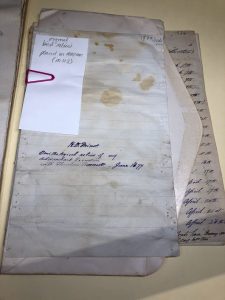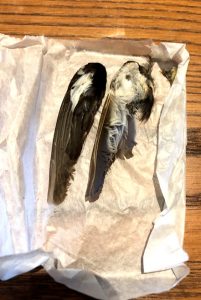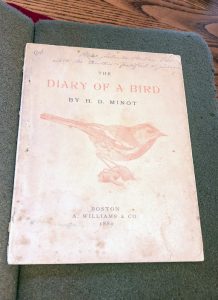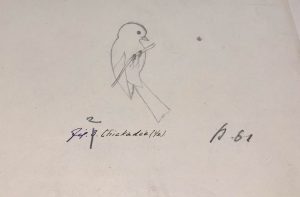by Hannah Elder, Library Assistant
During American Archives Month, I told the blog that one of my favorite collections at the MHS is the Audubon Society of Massachusetts Records. Mass Audubon was founded by Harriet Hemenway and Minna Hall, two Boston women who used their social standing to save birds by persuading other upper-class women to abandon the fashion of wearing feathers. Today, I want to introduce you to another champion for birds: Henry Davis Minot.
Minot was born near Forest Hills in 1859, the sixth of seven children of William and Katharine Maria Sedgwick Minot. He took an early interest in ornithology, recording careful observations of what he believed to be a new species of bird in May of 1871. In 1876, Minot entered Harvard University, where he befriended fellow ornithological enthusiast Theodore Roosevelt. Throughout their friendship, the two exchanged letters and went on birding expeditions. During one expedition in the Adirondacks in 1877, Minot caught and preserved the wings of a blackburnian warbler. The preserved relics were placed in Minot’s personal papers and were found by an archivist when the collection was processed.


Minot left Harvard in his sophomore year and entered the railroad industry, but he never left behind his interest in ornithology. Throughout his travels to Mexico, England and Scotland, and the American Midwest, he kept counts of the birds he saw and made observations of species that were new to him. He wrote multiple books and essays on birds, including Land-Birds and Game-Birds of New England (1877), Notes on Colorado Birds (1880), and New England Bird Life (1881).
In 1880, Minot became not just an observer of birds, but an advocate for them with the publication of Diary of a Bird, Freely Translated into Human Language. In this short publication, Minot acts as “translator” for a black-throated green warbler who has kept a diary “for the purpose of amusing, instructing, and enlightening mankind,” even though the diarist claims he does not approve of the practice of diary-keeping amongst birds. The diarist does not have a name; he writes, “in a bird-community, every member is expected to know his own mate and children; beyond that, we make no distinctions . . . . I myself, for instance, have no individual name, and am very well content; for among us are no rights of property and inheritance, no law-suits, no marriage-ceremonies; but each of us lives for himself.” The warbler writes of the end of his migration from southern Mexico to the White Mountains, his mate’s efforts to build a nest and sit on their eggs, a run-in he has with a birder, and the activities of raising his family. Our feathered diarist often makes use of turns of phrase used only by birds (for instance, he once describes a lake as being “as long as the flight of a heron with thirty or more wing-beats), which Minot, as translator, helpfully explains. (Thirty heron wing-beats is about 500 feet, if you were wondering!)

The major event of the diary is a meeting in early September of all of the birds of Massachusetts, organized to discuss “The Destruction and Extermination of Birds; how caused and how to be prevented.” The meeting, held in the middle of the woods to avoid notice by humans, is attended by all types of birds, leaving our warbler amazed at the sight of so many feathered friends. During the meeting, various species of birds describe their greatest threat. It is widely agreed that humans, with their traps, guns, nets, light-houses, clear-cutting, and domesticated cats, are the most dangerous threat to birds. Our diarist writes:
Men seem not only for the most part to have lost all appreciation of Nature, the best source of health and pleasure . . . but to be so utterly improvident as not to appreciate the mischief they are doing to themselves, or at least to their young, in deforesting the country. Their depravity is melancholy. Can’t they live without disturbing Nature, just as birds do? I can’t understand why they should ruin large tracts of country, as they often do, and then, instead of using them, leave them covered with pine-stumps, and bushes or stunted saplings.
As the warbler is speaking out against the use of birds in human fashions, the meeting is interrupted by the foe himself: a man with a gun, intent on shooting our diarist and his friends. I’ll leave it to you to find out what happens…
For Minot, the Diary was “a serious appeal for wiser thought and stronger action in the matter of protection of our birds” (letter to John Burroughs, 20 March 1880). He sent copies of the book to naturalists and it received praise and statements of hope for the future from some of them. In March of 1880, naturalist Samuel Lockwood wrote “This plea is very prettily put; and most heartily do I wish it God’s speed. . . . I love the birds, and cannot shoot them . . . Would that your little Warbler’s life story might still many a gun” (letter to Henry Davis Minot).

Sadly, Minot died in a train collision in 1890, so he never saw the conservation efforts of the Massachusetts Audubon Society, which was founded in 1896. I like to think that he would have appreciated and supported their cause.
If you would like to learn more about Minot’s ornithological pursuits, the Massachusetts Audubon Society, or the personal papers of other Massachusetts ornithologists, please consider visiting the library!

